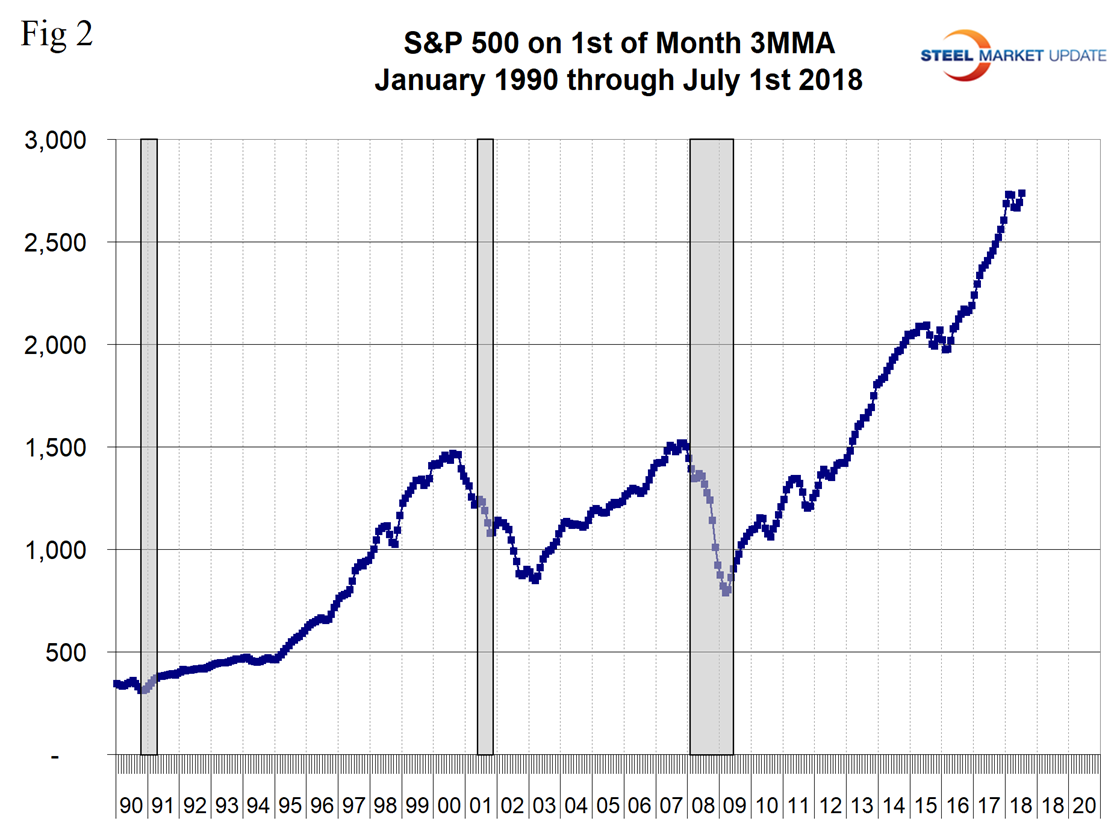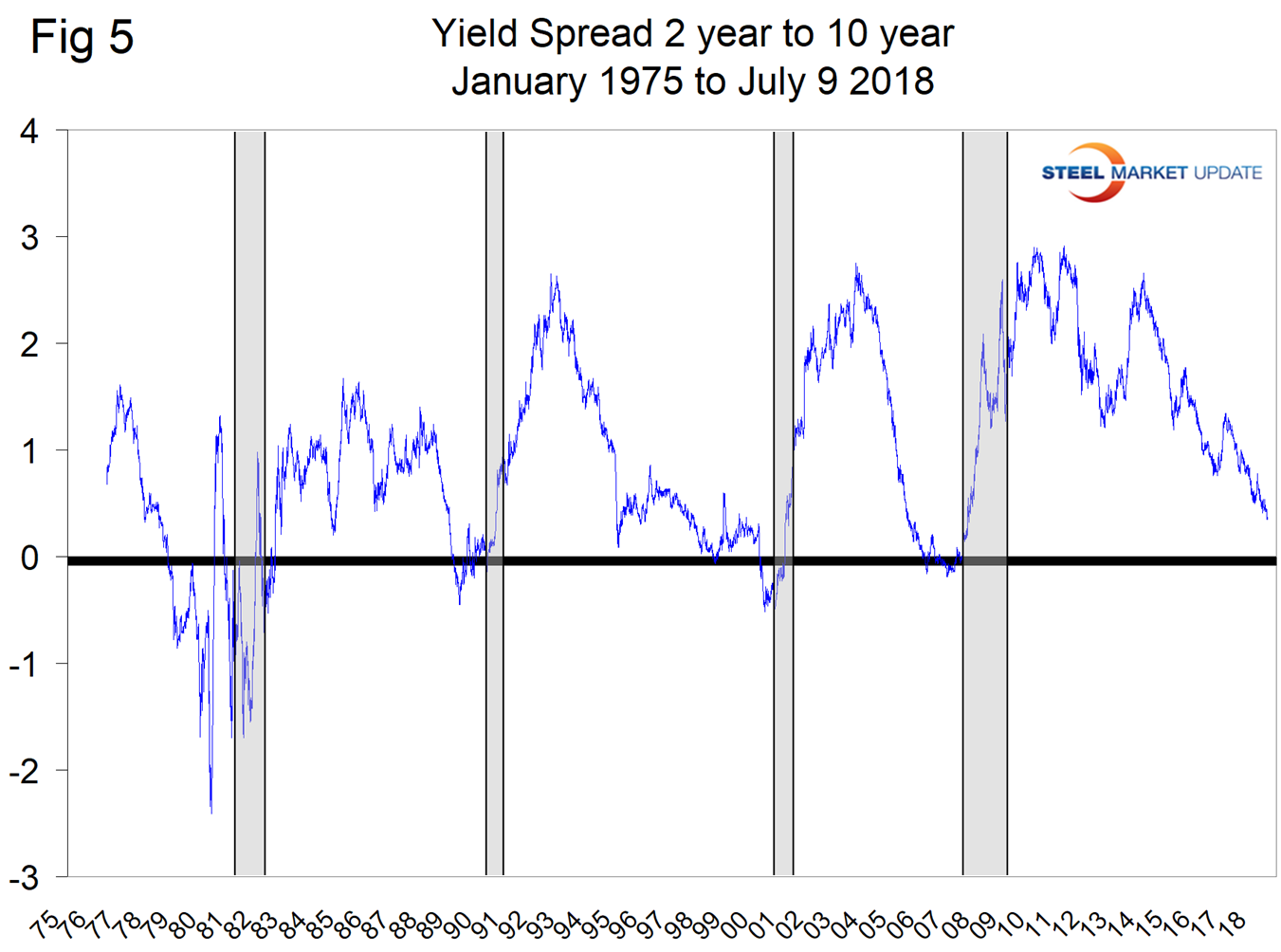Economy

SMU Recession Monitor: Keep an Eye on the Yield Curve
Written by Peter Wright
July 15, 2018
Indicators of economic activity in the U.S. do not predict a recession, but keep a close eye on the yield curve.
Economists consider recessions to be a necessary evil to clear out distortions that have arisen in the economy. At Steel Market Update, we track several leading indicators of economic activity. Viewed individually, they offer limited insight on economic expansion or contraction. Viewed collectively they give subscribers a better idea of present and future business activity. Since World War II, most recessions have been preceded by an overheated economy as indicated by low unemployment, tighter monetary policy and rising long-term interest rates.
![]() Figure 1 provides a history of U.S. recessions since 1970. Recessions occurred in 1974, 1980, 1981, 1990, 2001 and 2008. In Q1 2018, the latest data, the Bureau of Economic Analysis (BEA) reported the growth of GDP to be 1.98 percent. This is a quarter on quarter result. On a trailing 12-month basis, GDP growth in Q1 was 2.77 percent. Economists expect that when Q2 results are reported, there will be a surge in quarter-on-quarter growth.
Figure 1 provides a history of U.S. recessions since 1970. Recessions occurred in 1974, 1980, 1981, 1990, 2001 and 2008. In Q1 2018, the latest data, the Bureau of Economic Analysis (BEA) reported the growth of GDP to be 1.98 percent. This is a quarter on quarter result. On a trailing 12-month basis, GDP growth in Q1 was 2.77 percent. Economists expect that when Q2 results are reported, there will be a surge in quarter-on-quarter growth.

Figure 2 shows the three-month moving average of the S&P 500 on the first day of each month from January 1990 through July 2018. The stock market did predict the recession of 2001, but failed in 2008. The tendency is that stock prices decline as investors anticipate a weakening economy and flagging corporate earnings. Fed tightening is also a factor in 2018. A year-over-year decline in stock prices has historically led recessions by one or two quarters. The three-month moving average (3MMA) of the S&P 500 declined in March, April and May, but recovered in June and July.

Figure 3 records new weekly claims for unemployment compensation. This indicator failed to predict the 1981 and 2008 recessions. It had a lead of over a year on the other four. Initial claims for unemployment insurance, reported weekly, are a sensitive measure of layoffs. Initial claims are currently at a 50-year low.

Figure 4 shows consumer confidence. When consumers, businesses and investors lose confidence, it sets up a downward self-reinforcing spiral of reduced spending and investment, causing even higher unemployment, and further depressing confidence. The consumer’s sentiment about the present situation and future expectations are both strong and above their long-term trend lines.

Figure 5 is the well-known yield spread and shows a negative or “inverted” yield curve to be a sign of imminent recession. The treasury spread is developed by subtracting a shorter-term from a longer-term treasury yield. Ten-year interest rates minus two-year interest rates, for example. This has been one of the most accurate and longstanding leading indicators for growth and inflation. A spread that is increasing is a sign of higher growth and inflation as bank lending becomes more profitable (borrow short and lend long) and loan growth is expected to accelerate. A declining or contracting yield spread foreshadows lower growth and inflation due to contractions in bank loan growth due to reduced profitability. The current forecast predicts that lower growth and inflation will materialize toward the end of this calendar year and, more specifically, the first several months of next year. That thesis has been unfolding as the yield curve is contracting. A negative spread anticipated all five of the recessions since 1975. If as expected the Fed tightens rates in September, the yield curve is likely to become almost completely flat, meaning that the yield spread will be close to zero. When the spread becomes negative, the money supply gets shut off because banks’ loans are earning less than their liabilities, which are deposits.

Figure 6 is the chart we like best, though we have no history before 2008. This is The Conference Board leading and lagging economic index. We have subtracted one from the other in the rationale that if the lead is better than the lag, the situation is improving, or vice versa. The lead minus lag inverted three years in advance of the 2008 recession. Certainly, 18 months before the big event it was clear something was happening. In May 2018, the spread declined slightly, but it’s too soon to say if this is a negative trend.

Figure 7 summarizes this data as a recession heat map. Only the yield curve is showing signs of distress. Unfortunately, that has been the most prescient in the past.

A study of the current data shows a generally healthy U.S. economy. We will release this update every three months and continue to refine it. When we see a recession on the horizon, we will report more frequently.

Peter Wright
Read more from Peter WrightLatest in Economy

ISM: Manufacturing expansion loses steam after two months of growth
US manufacturing activity slowed in March after two straight months of expansion, according to supply executives contributing to the Institute for Supply Management (ISM)’s latest report.

Chicago Business Barometer rose to 16-month high in March
The Chicago Business Barometer increased for the third-consecutive month in March. Despite this, it still reflects contracting business conditions, as it has since December 2023.

Durable goods orders rise again in February
Transportation equipment led the increase, rising 1.5% to $98.3 billion.

Consumer confidence falls for fourth consecutive month
People remain concerned about inflation, trade policies, and tariffs.

Housing starts ticked up in February
Single-family starts last month hit a rate of 1.10 million, a month-over-month increase of 11.4%, census data shows.
